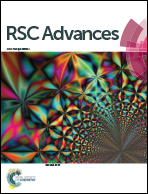Protective effects of the flavonoid fraction obtained from pomelo fruitlets through ultrasonic-associated microwave extraction against AAPH-induced erythrocyte hemolysis†
Abstract
Pomelo fruitlet is a side-product of pomelo, and this study aimed to extract the antioxidative flavonoid compounds from pomelo fruitlets with high efficiency through ultrasonic-associated microwave methods. Scanning electron microscopy analysis indicated that the spatial structure of the pomelo fruitlet powder was changed; microwaves and ultrasonic waves facilitated the formation of globular and curved surfaces, respectively. Ultrasonic-microwave synergistic pretreatment resulted in significantly higher yield. Each type of flavonoid compound was characterized using PR-LCMS analysis, and naringin with high nutritive value was detected in all groups. After purifying the flavone fractions with AB-8 macroporous resin, naringin, 2′′-O-acetyl-3′-O-methylrutin, and 5,7,8,3′-tetrahydroxy-3,4′-dimethoxy were identified, which could act as free radical scavengers to protect erythrocytes from AAPH-induced hemolysis. This study strongly improved the effects of ultrasonic-microwave synergetic methods on the high utilization of pomelo fruitlets, especially in terms of flavonoid extraction and bioavailability.



 Please wait while we load your content...
Please wait while we load your content...